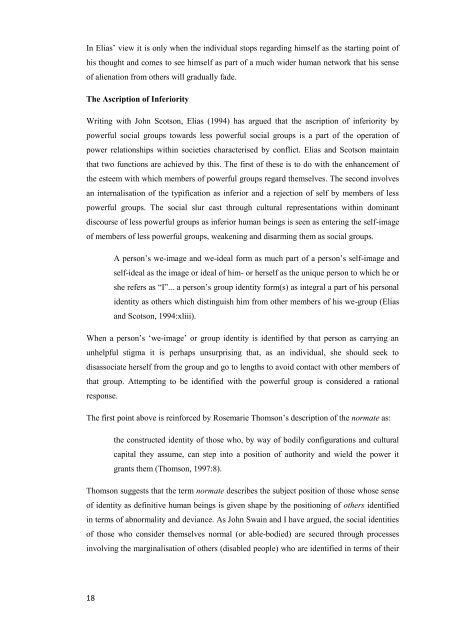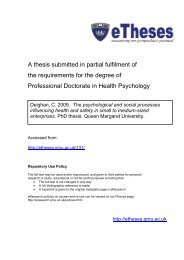A thesis submitted in partial fulfilment of - Etheses - Queen Margaret ...
A thesis submitted in partial fulfilment of - Etheses - Queen Margaret ...
A thesis submitted in partial fulfilment of - Etheses - Queen Margaret ...
You also want an ePaper? Increase the reach of your titles
YUMPU automatically turns print PDFs into web optimized ePapers that Google loves.
In Elias‟ view it is only when the <strong>in</strong>dividual stops regard<strong>in</strong>g himself as the start<strong>in</strong>g po<strong>in</strong>t <strong>of</strong><br />
his thought and comes to see himself as part <strong>of</strong> a much wider human network that his sense<br />
<strong>of</strong> alienation from others will gradually fade.<br />
The Ascription <strong>of</strong> Inferiority<br />
Writ<strong>in</strong>g with John Scotson, Elias (1994) has argued that the ascription <strong>of</strong> <strong>in</strong>feriority by<br />
powerful social groups towards less powerful social groups is a part <strong>of</strong> the operation <strong>of</strong><br />
power relationships with<strong>in</strong> societies characterised by conflict. Elias and Scotson ma<strong>in</strong>ta<strong>in</strong><br />
that two functions are achieved by this. The first <strong>of</strong> these is to do with the enhancement <strong>of</strong><br />
the esteem with which members <strong>of</strong> powerful groups regard themselves. The second <strong>in</strong>volves<br />
an <strong>in</strong>ternalisation <strong>of</strong> the typification as <strong>in</strong>ferior and a rejection <strong>of</strong> self by members <strong>of</strong> less<br />
powerful groups. The social slur cast through cultural representations with<strong>in</strong> dom<strong>in</strong>ant<br />
discourse <strong>of</strong> less powerful groups as <strong>in</strong>ferior human be<strong>in</strong>gs is seen as enter<strong>in</strong>g the self-image<br />
<strong>of</strong> members <strong>of</strong> less powerful groups, weaken<strong>in</strong>g and disarm<strong>in</strong>g them as social groups.<br />
18<br />
A person‟s we-image and we-ideal form as much part <strong>of</strong> a person‟s self-image and<br />
self-ideal as the image or ideal <strong>of</strong> him- or herself as the unique person to which he or<br />
she refers as “I”... a person‟s group identity form(s) as <strong>in</strong>tegral a part <strong>of</strong> his personal<br />
identity as others which dist<strong>in</strong>guish him from other members <strong>of</strong> his we-group (Elias<br />
and Scotson, 1994:xliii).<br />
When a person‟s „we-image‟ or group identity is identified by that person as carry<strong>in</strong>g an<br />
unhelpful stigma it is perhaps unsurpris<strong>in</strong>g that, as an <strong>in</strong>dividual, she should seek to<br />
disassociate herself from the group and go to lengths to avoid contact with other members <strong>of</strong><br />
that group. Attempt<strong>in</strong>g to be identified with the powerful group is considered a rational<br />
response.<br />
The first po<strong>in</strong>t above is re<strong>in</strong>forced by Rosemarie Thomson‟s description <strong>of</strong> the normate as:<br />
the constructed identity <strong>of</strong> those who, by way <strong>of</strong> bodily configurations and cultural<br />
capital they assume, can step <strong>in</strong>to a position <strong>of</strong> authority and wield the power it<br />
grants them (Thomson, 1997:8).<br />
Thomson suggests that the term normate describes the subject position <strong>of</strong> those whose sense<br />
<strong>of</strong> identity as def<strong>in</strong>itive human be<strong>in</strong>gs is given shape by the position<strong>in</strong>g <strong>of</strong> others identified<br />
<strong>in</strong> terms <strong>of</strong> abnormality and deviance. As John Swa<strong>in</strong> and I have argued, the social identities<br />
<strong>of</strong> those who consider themselves normal (or able-bodied) are secured through processes<br />
<strong>in</strong>volv<strong>in</strong>g the marg<strong>in</strong>alisation <strong>of</strong> others (disabled people) who are identified <strong>in</strong> terms <strong>of</strong> their




